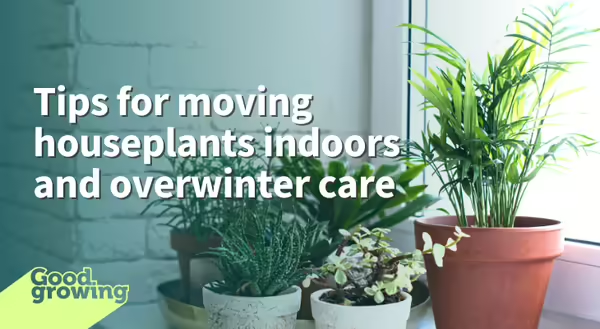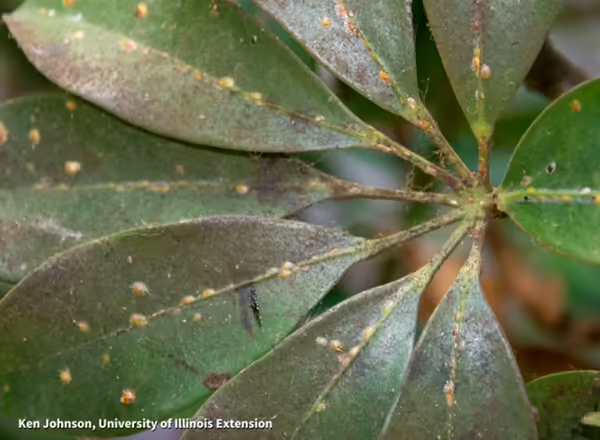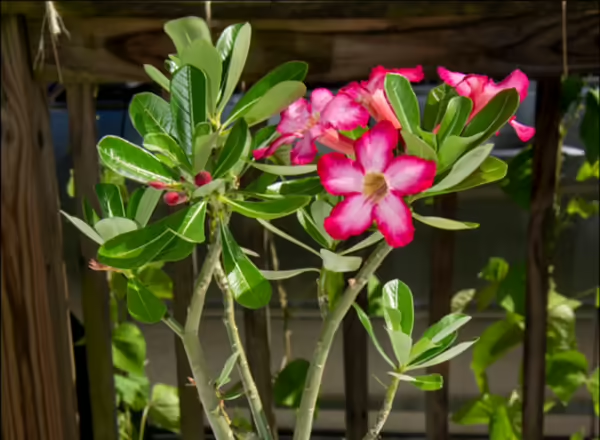
As we draw nearer to fall, it's time to start thinking about bringing houseplants back indoors for the winter. Many houseplants are native to tropical and subtropical climates and, while they may do great outdoors during the summer, cannot tolerate our cold temperatures. When the thermometer starts to get below 55 °F consistently, it's time to start bringing houseplants back indoors.
Inspect your plants before bringing them indoors
Before bringing plants back indoors, make sure to inspect them for any insects and other pests. Insects such as aphids, whiteflies, mealybugs, and scale, as well as spider mites, are some pests that are commonly found on plants outdoors. If allowed indoors, their populations can rapidly increase and spread to other plants.
One way you can try to get rid of any pests that may be present is to spray them off your plants with a hose. If you go this route, it may take several attempts to get rid of all of the pests. Pests that are firmly attached to plants, such as scales, can be scraped off or wiped off with a sponge.
If spraying with water doesn't work, insecticides such as pyrethrin, insecticidal soaps, and neem can be used. Just make sure to read and follow the label instructions. If your plants are infested, it may be best to dispose of them and purchase new plants.
In addition to checking the foliage, make sure to check the growing media. Insects such as earwigs and ants will often inhabit the growing media in potted plants. If you have insects or other critters inhabiting your soil, flush pots with water to drive them out. You may need to repot the plant if ants are present in the growing media.
Once you bring your plants indoors, keep them isolated from other plants for several weeks. This will help prevent any pests you missed from spreading to other plants you have indoors. After 3-4 weeks, if you don't notice any pests on the plants you brought indoors, it should be safe to move them closer to your other plants.
Caring for plants once they're indoors
Plants will likely slow down their growth considerably when brought indoors, so less water and fertilizer will be needed. For most plants, you should allow the soil to dry slightly between watering and stop fertilizing until the spring.
Light
Light levels indoors are much lower than outdoors, even compared to shaded areas. This reduction in light intensity often results in yellowing leaves and leaf drop. Eventually, plants will begin to produce new leaves.
Once plants are moved indoors, put them next to the brightest, sunniest window, which is typically south or west facing. If you can't give your plants enough light, provide supplemental lighting.
Temperature
Another thing to consider when selecting somewhere to place your plants is temperature. Try to avoid placing plants in areas where they will be exposed to drafts or too close to heat vents. For the most part, houseplants prefer daytime temperatures to be between 65° and 75° and about 10° cooler at night.
Watering
If you're not sure if your plants need water, there are a couple of ways you can check. First is with your finger. Stick your finger in your potting media up to your second knuckle; if the media is still moist, you probably don't need to water. Alternatively, you can lift the pot; if it feels light, it may be time to water.
Plants can be watered by top or bottom watering. If top watering, apply enough water so that some comes out of the drainage holes at the bottom of the pot. Make sure to discard any water that collects in the plant saucer. If your plants are really dry, you may need to repeat this several times to thoroughly remoisten your potting mix.
To water from the bottom, fill your plant saucer or sink with a few inches of water and let your plants soak. Once the potting mix on the top of the pot is moist, the plant can be removed from the water.
Occasionally the pots of houseplants are placed inside a more decorative-looking pot that often does not have a drainage hole (we often see this during the holidays). If you have pots like this, make sure to check the outer decorative pot doesn't fill with water.
Humidity
Humidity levels in your home will be much lower than what your plants were exposed to outdoors. Additionally, most houseplants come from tropical areas and do best with higher humidity levels than we typically see indoors during the winter (can be as low as 10-20%). There are several ways you can try to increase the humidity around your houseplants:
- Kitchens and bathrooms often have higher humidity levels than other rooms. If you have space and enough light, consider placing your houseplants in these rooms.
- Place plants close together. Plants lose water through transpiration. If they are clustered together, this can create a microclimate with higher humidity.
- You can place your plants on a shallow tray with gravel and water. As the water evaporates, it will increase the humidity in the area. Make sure your pots are not sitting in water, though (keep the water level below the top of the rocks).
- You can use a humidifier to help increase the humidity near plants.
- Misting plants is commonly recommended to help with humidity levels. However, misting only increases the humidity levels for a short period of time (minutes). For misting to be effective, you would need to mist plants every few minutes.
Good Growing Tip of the Week: To help get your houseplants acclimated to lower light levels indoors, you can move plants to a shaded area in your landscape for a week. Then start moving them indoors for a day or two and gradually increasing the amount of time.
Signup for our emails! Want to get notified when new Good Growing posts are available? SIGN ME UP
MEET THE AUTHOR
Ken Johnson is a Horticulture Educator with University of Illinois Extension, serving Calhoun, Cass, Greene, Morgan, and Scott counties since 2013. Ken provides horticulture programming with an emphasis on fruit and vegetable production, pest management, and beneficial insects. Through his programming, he aims to increase backyard food production and foster a greater appreciation of insects.

